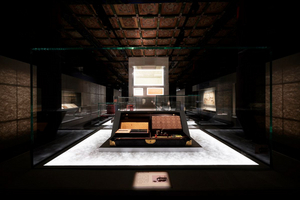Exhibition Designed By New York-Based OLI Architecture Now Open In The Forbidden City, China
Mirroring the Heart of Heaven and Earth: Ideals and Images in the Chinese Study brings together works spanning from antiquity to contemporary art.

Mirroring the Heart of Heaven and Earth: Ideals and Images in the Chinese Study, an exhibition designed by New York-based firm OLI Architecture, has opened in the Palace Museum. Located in the center of the 72-hectare complex in the Forbidden City, built in the fifteenth century, the museum houses one of the world's largest collections of ancient Chinese artifacts, calligraphy, paintings, and porcelain. Working closely with curators at The Palace Museum, OLI Architecture has created a space that brings together art and objects spanning from antiquity to contemporary art within the historical architecture.
Housed in the Meridian Gate Galleries, Mirroring the Heart of Heaven and Earth centers on the evolving role of the scholar throughout Chinese history, exploring the relationship to the court, to other scholars, the natural world, and the universe. The exhibition brings together 105 works ranging from antiquities to contemporary art, including books, scrolls, vases, sculptures, paintings, screens, cups, and seals. Alongside the art, the displays also include materials such as brushes, ink, and paper ranging from the 6th to the 21stt centuries. The three gallery wings are divided into three chapters: "Chapter One: Sanctuary of Literature and Music," "Chapter Two: A Channel for Enlightenment," and "Chapter Three: A Bond of Companionship." These chapters deal respectively with the themes of a spiritual haven; self-cultivation and the bond between humanity and nature; and the appreciation of the finitude of life against the infinity of the universe.
The exhibition encourages a dialogue between heritage objects and modern artworks. For instance, an eighteenth-century plaque bearing the words 'Chamber of the Five Classics' in the Qianlong Emperor's hand, that typically hangs in the hall that served as the imperial study, is prominently displayed at the beginning of the exhibition. The Five Classics include some of the oldest surviving Chinese texts and are the central works of Confucianism.
Contemporary artists represented include:
- Liu Dan (b. 1953) an ink painter trained in traditional style ink painting, he lives and works in Beijing, China.
- Xu Bing (b. 1955) is a multimedia artist known for his calligraphy and printmaking, who divides his time between New York City and Beijing.
- Xu Lei (b. 1963) an ink painter heavily involved in China's 1980's New Wave movement who currently serves as the Art Director of Beijing's Today Art Museum.
- Bai Ming (b. 1965) a ceramicist and painter who teaches at Tsinghua University in Beijing.
- Young Ho Chang (b. 1956) an award-winning architect and researcher who is currently a professor of architecture at MIT.
Hiroshi Okamoto, Founding Partner of OLI Architecture, remarks, "Our office often works with contemporary art and artists. It was a challenge to design this remarkable exhibition with pieces from famous contemporary artists paired with such rare and prominent antiquities. When we started the project the idea of the scroll and the ephemerality of paper became a central concept. Where the art and antiquities were displayed on a transparent softly glowing surface which flowed from the vertical to the horizontal at the datum of a scholar's table height giving the viewer an intimate experience."
Having a combined work experience of over thirty years on signature museum, civic and institutional projects worldwide, the founding members, Hiroshi Okamoto and Bing Lin joined their expertise in collaboration forming OLI Architecture PLLC in 2010. With a vision towards the future, grounded in a thorough disciplinary understanding of the built environment, and respect of the specific cultural parameters of each project, the firm offers full service architectural design. OLI's specialty expertise consists of civic and cultural building design, museography, exhibition design, education, healthcare, and custom residential design.
The firm's approach is to investigate the specific nature of each project to craft a design response to meet the aspirations of the client, stakeholders, and the detailed requirements of the future occupants. OLI transforms these contextual studies using physical, digital, and parametric models, and computational analyses to create the unique tectonics of each project. These are then articulated with local construction practices and standards to create a unique building that merges with the cultural environment of its site. See more at oliarch.com/en/home.
Videos

